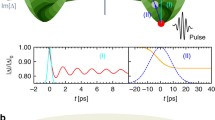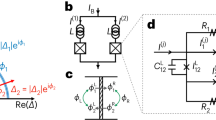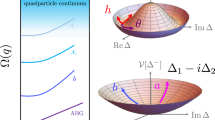Abstract
By the study of the spectrum of collective modes in a pure d-wave state and in a mixed d x 2 y 2 + id xy state of high-temperature superconductors, we show that in spite of the fact that spectra in both pure states d x 2 y 2 and d xy are identical, the spectrum in the mixture d x 2 y 2 + id xy state turns out to be quite different from them. Thus, the probe of the spectrum in ultrasound and/or microwave absorption experiments could be used to distinguish a mixture of two d-wave states from pure d-wave states.
Similar content being viewed by others
References
J. F. Annett, N. D. Goldenfeld, and A. J. Leggett, “Experimental constraints on the pairing state of the cuprate superconductors: an emerging consensus,” in: Physical Properties of High Temperature Superconductors, V (D. M. Ginsberg, ed.), World Scientific, River Ridge, New Jersey (1996), p. 375.
A. V. Balatsky, P. Kumar, and J. R. Schrieffer, “Collective mode in a superconductor with mixedsymmetry order parameter components,” Phys. Rev. Lett., 84, 4445 (2000).
P. N. Brusov, Mechanisms of High Temperature Superconductivity, Vols. 1, 2, Rostov State Univ. Publ., Rostov-on-Don (1999).
P. N. Brusov and P. P. Brusov, “A method of distinction of a mixed d x 2 − y 2 + d xy -state of HTSC from the pure d-wave state,” Phys. B, 281–282, 949 (2000).
P. N. Brusov and P. P. Brusov, “Collective properties of superconductors with nontrivial pairing,” Sov. Phys. JETP, 119, 913–930 (2001).
P. N. Brusov, P. P. Brusov, and Chong Lee, “Collective properties of unconventional superconductors,” Int. J. Mod. Phys. B, 18, 867–882 (2004).
P. N. Brusov, P. P. Brusov, P. Majumdar, and N. Orekhova, “Ultrasound attenuation and collective modes in mixed d x 2 − y 2 +d xy state of unconventional superconductors,” Brazil. J. Phys., 33, 729–732 (2003).
P. N. Brusov and N. P. Brusova, “The model of d-pairing for superconductors and superfluids,” Phys. B, 194–196, 1479 (1994).
P. N. Brusov and N. P. Brusova, “The model of d-pairing in CuO2 planes of HTSC and collective modes,” J. Low Temp. Phys., 101, 1003 (1996).
P. N. Brusov, N. P. Brusova, and P. P. Brusov, “The path integral model of d-pairing superconductors,” Czechosl. J. Phys., 46, (Suppl. s2):1041 (1996).
P. N. Brusov, N. P. Brusova, and P. P. Brusov, “The collective excitations in heavy-fermion superconductors under d-pairing,” Phys. B, 259–261, 496 (1999).
P. N. Brusov, N. P. Brusova, and P. P. Brusov, “The functional integral model of d-pairing superconductors,” Fiz. Nizk. Temp., 22, 506 (1996).
P. N. Brusov, N. P. Brusova, and P. P. Brusov, “The collective excitations of the order parameter in HTSC and heavy fermion superconductors (HFSC) under d-pairing,” J. Low Temp. Phys., 108, 143 (1997).
P. N. Brusov, N. P. Brusova, P. P. Brusov, and N. N. Harabaev, “The collective modes in HTSC and heavy fermion superconductors (HFSC) under d-pairing,” Phys. C, 282–287, 1881 (1997).
J. R. Feller, C. C. Tsai, J. B. Ketterson, J. L. Smith, and B. K. Sarma, “Evidence of electromagnetic absorption by collective modes in the heavy fermion superconductor UBe13,” Phys. Rev. Lett., 88, 247005 (2002).
K. Krishana, N. P. Ong, Q. Li, G. D. Gu, and N. Koshizuka, “Plateaus observed in the field profile of thermal conductivity in the superconductor Bi2 Sr2 Ca Cu2 O8,” Science, 277, 83–85 (1997).
R. B. Laughlin, “Magnetic induction of dx2−y2 + idxy order in high-Tc superconductors,” Phys. Rev. Lett., 80, 5188 (1998).
Author information
Authors and Affiliations
Corresponding author
Additional information
Translated from Sovremennaya Matematika i Ee Prilozheniya (Contemporary Mathematics and Its Applications), Vol. 96, Geometry and Analysis, 2015.
Rights and permissions
About this article
Cite this article
Brusov, P.N., Filatova, T.V. How to distinguish a mixture of two d-Wave States from a Pure d-Wave State of High-Temperature Superconductors. J Math Sci 217, 628–638 (2016). https://doi.org/10.1007/s10958-016-2995-7
Published:
Issue Date:
DOI: https://doi.org/10.1007/s10958-016-2995-7




